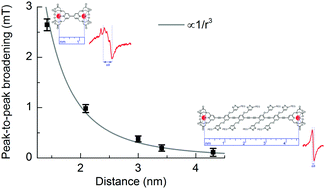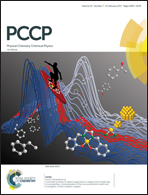Gd3+–Gd3+ distances exceeding 3 nm determined by very high frequency continuous wave electron paramagnetic resonance†
Abstract
Electron paramagnetic resonance spectroscopy in combination with site-directed spin labeling is a very powerful tool for elucidating the structure and organization of biomolecules. Gd3+ complexes have recently emerged as a new class of spin labels for distance determination by pulsed EPR spectroscopy at Q- and W-band. We present CW EPR measurements at 240 GHz (8.6 Tesla) on a series of Gd-rulers of the type Gd-PyMTA–spacer–Gd-PyMTA, with Gd–Gd distances ranging from 1.2 nm to 4.3 nm. CW EPR measurements of these Gd-rulers show that significant dipolar broadening of the central |−1/2〉 → |1/2〉 transition occurs at 30 K for Gd–Gd distances up to ∼3.4 nm with Gd-PyMTA as the spin label. This represents a significant extension for distances accessible by CW EPR, as nitroxide-based spin labels at X-band frequencies can typically only access distances up to ∼2 nm. We show that this broadening persists at biologically relevant temperatures above 200 K, and that this method is further extendable up to room temperature by immobilizing the sample in glassy trehalose. We show that the peak-to-peak broadening of the central transition follows the expected 1/r3 dependence for the electron–electron dipolar interaction, from cryogenic temperatures up to room temperature. A simple procedure for simulating the dependence of the lineshape on interspin distance is presented, in which the broadening of the central transition is modeled as an S = 1/2 spin whose CW EPR lineshape is broadened through electron–electron dipolar interactions with a neighboring S = 7/2 spin.


 Please wait while we load your content...
Please wait while we load your content...